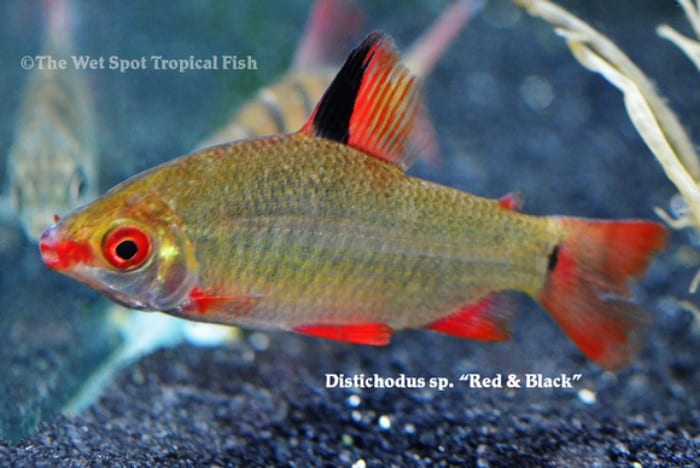Swimming to the Beat of their Own Drum
Swimming to the Beat of their Own Drum!
Since childhood, we are told that everyone is a unique snowflake. As we mature, we gain specialties and diversify our interests, so that no 2 people are exactly alike. Today, we’ll embrace this fact, and focus on some rare and unique freshwater African fish. These species are largely undescribed, which can offer surprises and an incredibly fulfilling stewardship experience to their keepers. Some of our favorite “black swans” of the fish world include Pungu maclareni, Parasicydium bandama, and Distichodus sp. “Red & Black”.
Scientific NamePungu maclareni
Common NameNone
Temperature / pH82 to 86°F / 7.5 to 8.5 pH
Native LocationCameroon
Preferred DietHerbivorous
Endemic only to a volcanic crater lake with 3 mile diameter in Cameroon, P. maclareni is a unique fish indeed. Inhabiting the shallow shorelines of the lake, this African cichlid is the only fish in its genus. Due to it’s incredibly limited habitat range, this fish is considered endangered from habitat loss, and captive breeding efforts are highly encouraged. They are maternal mouthbrooders, though there are few reports on successful captive breeding. It is generally suggested they be kept in species-specific tanks with sandy substrate, piles of rocks, and caves for breeding efforts. Reaching a maximum of 4 inches in length at maturity, these Pungus are yellow with navy blue chins and spotting. In their secluded habitats, these cichlids developed teeth to allow them to take advantage of abundant freshwater sponges as a food source. In captivity, they do best on vegetarian diets with very rare meaty treats. Tank waters should be maintained with temperatures between 82 and 86°F, with pH of 7.5 to 8.5, and hardness of 28 to 85 ppm.
Scientific NameParasicydium bandama
Common NameAfrican Algae Eating Goby
Temperature / pH71 to 82°F / 5.0 to 6.0 pH
Native LocationIvory Coast
Preferred DietSmall invertebrates/algae
Another lone genus member, P. bandama, is an African goby native to fast flowing streams and rivers of the Ivory Coast. These gobies, however, have a much greater geographic range due to their ability to migrate upstream, holding onto rocks and other surfaces with well developed pelvic fins. Tank set ups should include water-pump induced currents, a mix of sandy and small rocky substrate, piles of larger water-worn rocks, and at least some aquatic vegetation. Though they are rare, this species is considered of “least concern” on the IUCN Red List. Captive breeding is a difficult task for this species since adults live in freshwater, and larval forms mature in saltwater before migrating to their adult habitat. Reaching just over 2 inches in length at maturity, they exhibit very long bodies with reddish-brown coloration and mottled spots. In the wild, these gobies consume large quantities of aquatic invertebrates and insect larvae, and should be fed regular meals of live and frozen fare alongside high-quality meaty pellets, and regular supplementation of vegetal foods. Waters should be maintained with high levels of dissolved oxygen, temperatures between 71 and 82°F, pH of 5.0 to 6.0, and hardness of 18 to 143 ppm.
Scientific NameDistichodus sp. “Red & Black”
Common NameWatermelon Distichodus
Temperature / pH72 to 79°F / 6.0 to 7.5 pH
Native LocationCongo River
Preferred DietOmnivorous
Another rare, and largely undescribed freshwater specimen is D. sp. “Red and Black”, more commonly referred to as “Watermelon Distichodus”. The Wet Spot’s wild specimens come from a tributary of the Congo River in the Republic of the Congo known as the Lefini River. In captivity, these fish can reach 16 inches in length at maturity with shiny golden bodies, red lips, eyes and fins, with a dark black strip on the dorsal fin making it resemble a watermelon. While juvenile specimens do well in shoals or with similarly sized tank-mates, as they mature, they become more aggressive and territorial and not well suited for most community tanks. They can be kept in large enclosures with hardy catfish, bichirs, characins, and cyprinids. Tank set ups should include sand or gravel substrate, smooth rocks, driftwood, light water flow, and tight fitting lids to prevent jump-escapes. Aquatic plants will often be eaten by these species, and should not be included. These fish are omnivorous in nature and should be fed a variety of foods from earthworms to spirulina. Waters should be maintained with temperatures of 72 to 79°F, pH between 6.0 and 7.5, and hardness of 71 to 143 ppm.
Interested in starting your very own rare African fish tank, be it to contribute to captive breeding efforts of endangered specimens, or simply for your own viewing and interacting pleasure? Give us a call today to discuss your best options. Diversify your interests, and embrace these unique swimmers!


